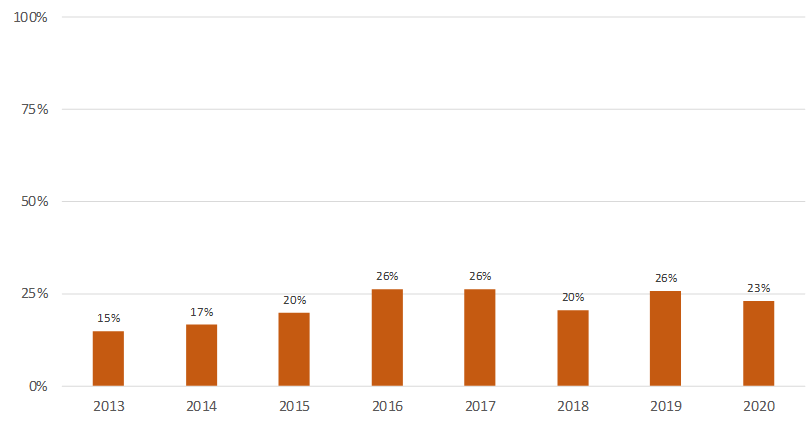Table of contents
1) Indicator text and figures
Summary
Pesticides[1] were assessed against effect or quality thresholds between 2013 and 2020. One or more pesticides was detected above its effect threshold at 15-26% of all surface water monitoring sites each year. Exceedances were mainly caused by the insecticide imidacloprid in surface waters, and the herbicides MCPA, metolachlor and metazachlor. Exceedances of one or more pesticides were detected at between 4% and 10% of groundwater monitoring sites, mainly by atrazine and its metabolites. No trends can be derived at this time and between-year changes may not be significant.
[1] Pesticides include both active substances from plant protection products and biocides as well as their relevant metabolites.
Figure 1. Percentage of reported monitoring sites with pesticides exceeding thresholds per year in a) surface waters and b) groundwater in Europe weighted by country area.
a)

b)

Pesticides can contaminate surface waters and groundwater and if their concentrations are above critical thresholds, they can be harmful to the environment.
The European Green Deal (EC 2019) sets targets to reduce the use of and risks from chemical pesticides by 50% by 2030 in the zero pollution action plan (EC 2021), farm to fork strategy (EC, 2020b) and biodiversity strategy (EC, 2020a), with a focus on protecting ecosystems and improving biodiversity.
The Water Framework Directive (WFD) (EU 2000) sets environmental quality standards for pesticides in surface water. To assess the chemical status of groundwater, a precautionary quality standard of 0.1µg/L is set for pesticides according to the Groundwater Directive (EU 2006), reflecting the desire to keep pesticide concentrations in groundwater at low levels.
Figure 1 shows that in 15% to 26% of all surface water monitoring sites, one or more pesticides were detected above effect threshold each year between 2013 and 2020. Exceedances of one or more pesticides were detected at between 4% and 10% of groundwater monitoring sites.
Pesticides most often causing exceedance in surface waters are the insecticide imidacloprid, and the herbicides MCPA, metolachlor and metazachlor, all of which were approved for use in plant protection products during the monitoring period, though some are no longer approved. In groundwater, the herbicide atrazine and its metabolites cause most exceedances. Atrazine was not approved for use in plant protection products during the monitoring period. Despite restrictions on atrazine since 2007, it continues to be found in groundwater because it is very persistent.
It is not yet possible to determine a trend in Figure 1. Losses from the application of pesticides may vary considerably between years, depending upon, for example, crop type and the weather, while the frequency of monitoring of pesticides in surface waters can be limited to one year out of three. Changes to the approval status of pesticides influence their use and presence in water, which can also lead to difficulties in interpreting trends over time. For these reasons, changes between years may not be significant. It is anticipated that a trend will become apparent in the next few years.
Figure 2. Percentage of reported monitoring sites with pesticides exceeding thresholds in surface waters, different sized rivers, lakes and groundwater in European countries in time period 2013 – 2020

Between 2013 and 2020, pesticides were reported from a total of 9,768 monitoring sites for surface waters and 13,863 sites for groundwater. The number of monitoring sites reporting data for surface waters varies by country from less than 10 sites (Hungary, Iceland, Luxembourg, Switzerland) to more than 1,000 sites (France, Italy, Spain). There is similar variation in groundwater monitoring sites: numbers range from 54 sites in Lithuania to more than 3,000 sites in Italy (and more than 1,000 sites in Austria, Denmark, France, Germany, Spain).
The number of pesticides reported in surface waters ranges from fewer than 10 substances (Iceland, Luxembourg, Norway, Switzerland) to more than 100 substances (Czechia, France, Germany, Italy, Netherlands, Spain). For groundwater, the lowest number of pesticides was reported from Austria (6) and the highest number from France (215).
Exceedance rates of more than 30% were reported in 16 out of 29 countries for surface waters and in one out of 22 countries for groundwater. High exceedance rates were mainly reported at monitoring sites in small and medium-sized rivers.


